Mozambique marked my first foray in Sub-Saharan Africa and I couldn’t have chosen a better destination to start with.
I spent a full month travelling across this country, and now? I’m fully obsessed with Mozambique. I can’t stop talking about how hard I’ve fallen for the beaches, the people, the sealife, the food, and the laid-back way of life.
This is one of my favourite countries on the planet and I’m so excited to start sharing why.
But first, let’s talk about expenses.
In this post-pandemic world, the cost of travel has been skyrocketing, but Mozambique has managed to remain relatively inexpensive.
Today, I’m going to be revealing exactly how much you can expect to spend on a trip to Mozambique.
I’ve been recording every single dollar, peso, and baht that I’ve spent on my travels since 2011 (I now have over 65 budget breakdowns on the site!), aiming to give you an accurate picture of how much you can expect to spend in every country around the world. Today, it’s Mozambique’s turn and I’m so excited to start sharing.
Let’s get started. Note that prices below are listed in Euros.
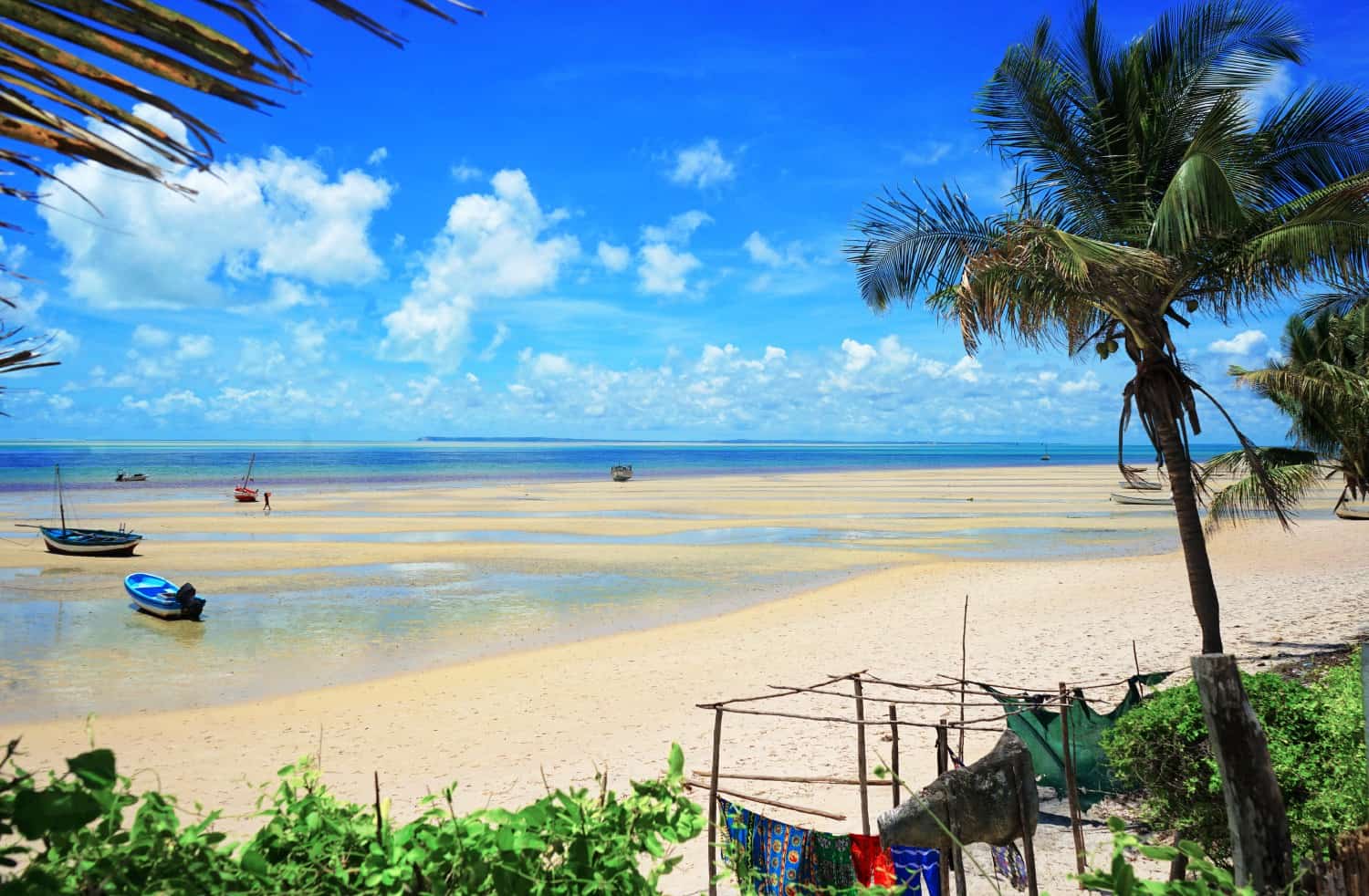
How to Save Money on Flights to/From Mozambique
Let’s start with actually getting to Mozambique. This country isn’t overrun with tourists, so you won’t find the same number of flight options that you would for a country like neighbouring South Africa.
Being based in Europe, I found the flight options to be super-reasonable, thanks to TAAG Angolan Airlines. In fact, my flight (with a layover in Luanda) was just €250 return from Lisbon, Portugal, meaning Mozambique was cheaper to fly to than many European destinations would have been!
Because of this, do keep an eye on Angolan Airlines’ website, just in case a sale happens to coincide with your travel dates.
Mozambique is a former Portuguese colony, so that also means that TAP (Portugal’s national airline) flies direct into Maputo for reasonable prices. Even when there aren’t sales on, it’s not hard to find return flights from Lisbon for under €700. If you’re based in Europe, then, you may find that it’s cheaper to fly first to Portugal, and then onwards to Mozambique.
As always, I recommend heading to Skyscanner to compare flight deals and find the cheapest option.
If you’re flexible with dates and itinerary, you’ll find the best deals by searching by setting your flight departure date to be across an entire month. This will show you the cheapest dates to fly and ensure you have the very best deal possible.
In general, you’ll find that it’s cheapest to fly to Mozambique outside of high season; low season is between January and April. Despite this being the middle of the rainy season, I visited in January and only had a single day of wet weather. It meant I was able to take advantage of the lower prices while also lounging on the beaches in the sun. I lucked out, of course, so visiting at this time of year does involve taking a risk on the weather.
September to November marks out the shoulder season, where you’ll encounter cooler weather and fewer tourists. If you do have the freedom to visit during shoulder season, I highly recommend it, as it’ll mean spending less on flights and accommodation while having to deal with fewer tourists. Shoulder season is my favourite time of year to travel, and it’s worth making the effort to do so in Mozambique.
What if you’re not in Europe?
Most travellers to Mozambique hail from South Africa, so flights are relatively inexpensive if that’s where you’ll be coming from — expect to pay R3000 return. Many people opt to drive into Mozambique as well, so that’s definitely an option if you’re keen to avoid flight and rental car costs.
In terms of my North America readers, getting to Europe is surprisingly cheap these days, and I wouldn’t expect you’d need to pay more than around $400 for a return ticket. Allow me to introduce you to one of my favourite websites in the world: Secret Flying! I’d estimate that half of the flights I book these days are due to a deal I’ve found on Secret Flying.
From Europe, you’ll then be able to utilise the tips above to score a cheap flight to Mozambique.
And for all of the above: you may find it cheaper to first look for flights to Johannesburg and then make your way to Mozambique from South Africa.
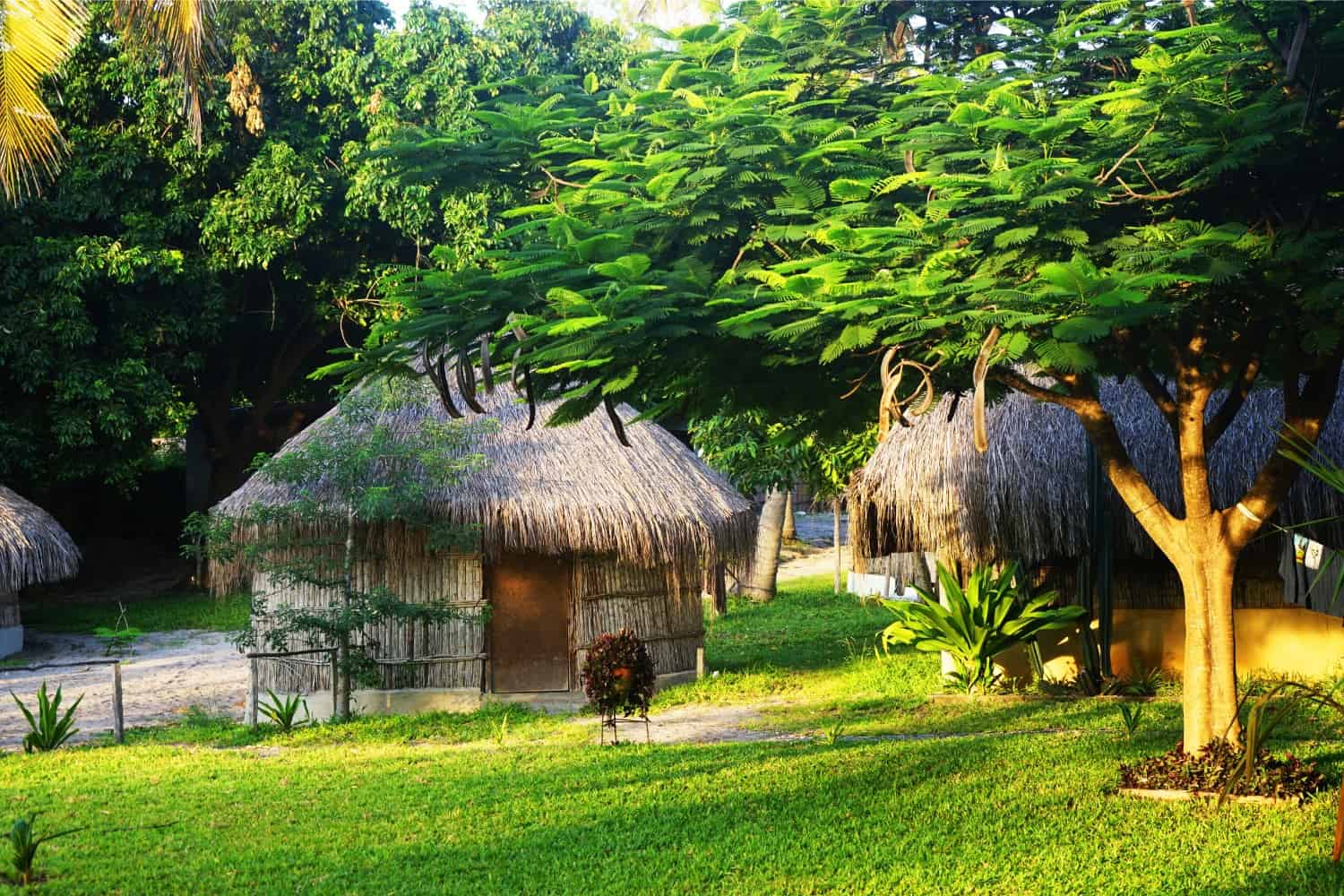
How to Save Money on Accommodation in Mozambique
Like practically every country in the world, prices have increased post-pandemic in Mozambique, so you’ll be paying a little more for everything than you would have done a few years ago. Despite that, costs are lower than most Western countries, so accommodation in the country still offers up good value for money.
Let’s start on the lower end of the spectrum. If you’re willing to put in the time and effort, it’s possible to avoid paying for accommodation entirely.
Couchsurfing exists in Mozambique and allows you to stay with a local for free, usually sleeping on their sofa and enjoying a local’s insight into life in their country. It’s not the most comfortable of living situations, and there aren’t a huge amount of hosts in Mozambique, but if you’re on a tight budget, it might be worth sending out a few requests to see if anything comes of it. You can browse through the 10,000-odd local hosts registered on the Couchsurfing site, but don’t rely on it if you’re used to bouncing your way from sofa to sofa elsewhere in the world; there’s not much a scene here.
Workaway is another option, where you can help provide work (farming, language-learning, charity work) in exchange for food and accommodation from a host. Its an excellent way to spend more time in Mozambique, get to know the country away from the tourist centres, and save on your travel budget.
And then we have hostels. In Mozambique, you’ll only find hostels in the most touristy of destinations (think: Maputo, Tofo, Vilanculos), and even then typically only one or two in each place. Where they do exist, though, they’re usually well-rated, clean, and one of your best options for saving money.
Hostels in Mozambique are on a par with much of south-eastern Africa, and you can expect to spend around €12 a night for a dorm bed for the best-rated hostels in the country
When it comes to private rooms in hostels, you’ll be looking at around €30 a night for a clean, basic room in a good location, so if you’re travelling with friends or with your partner, you may find it doesn’t cost much more to grab some privacy over settling for two beds in a dorm room.
In Mozambique, I recommend the following hostels.
- Maputo: Base Backpackers is the best spot for backpackers in Maputo, with a central location, helpful staff, and safe premises. Dorm rooms are €17 a night, while a private double is €41 a night. The property is extremely clean, the roof terrace offers up lovely views, and the Wi-Fi is fast. Overall, a great place to stay.
- Tofo: Kitesurf Tofo House is the best-rated hostel in the entire country, racking up an average review score of 9.8/10 on Booking! You’ll pay €10 a night for a bed in a four-person dorm, or €27 a night for a queen room. What I loved most about Kitesurf Tofo is its location: it’s close to the beach and close to the action, but just far enough away that you don’t have to deal with any noise. The owners are wonderful, the bedrooms beautiful, and the garden perfect for relaxing in.
- Vilanculos: Baobab Beach is the spot where everybody ends up staying in Vilanculos — myself included! It’s a fun, lively, friendly hostel, where it’s easy to make friends, excursions run everyday, and there’s still a calm, quiet atmosphere for when you need to sleep. Dorm beds start at just €13.50 a night, while private doubles come in at €36 a night.
And then there are hotels, which I’m going to jump into next.
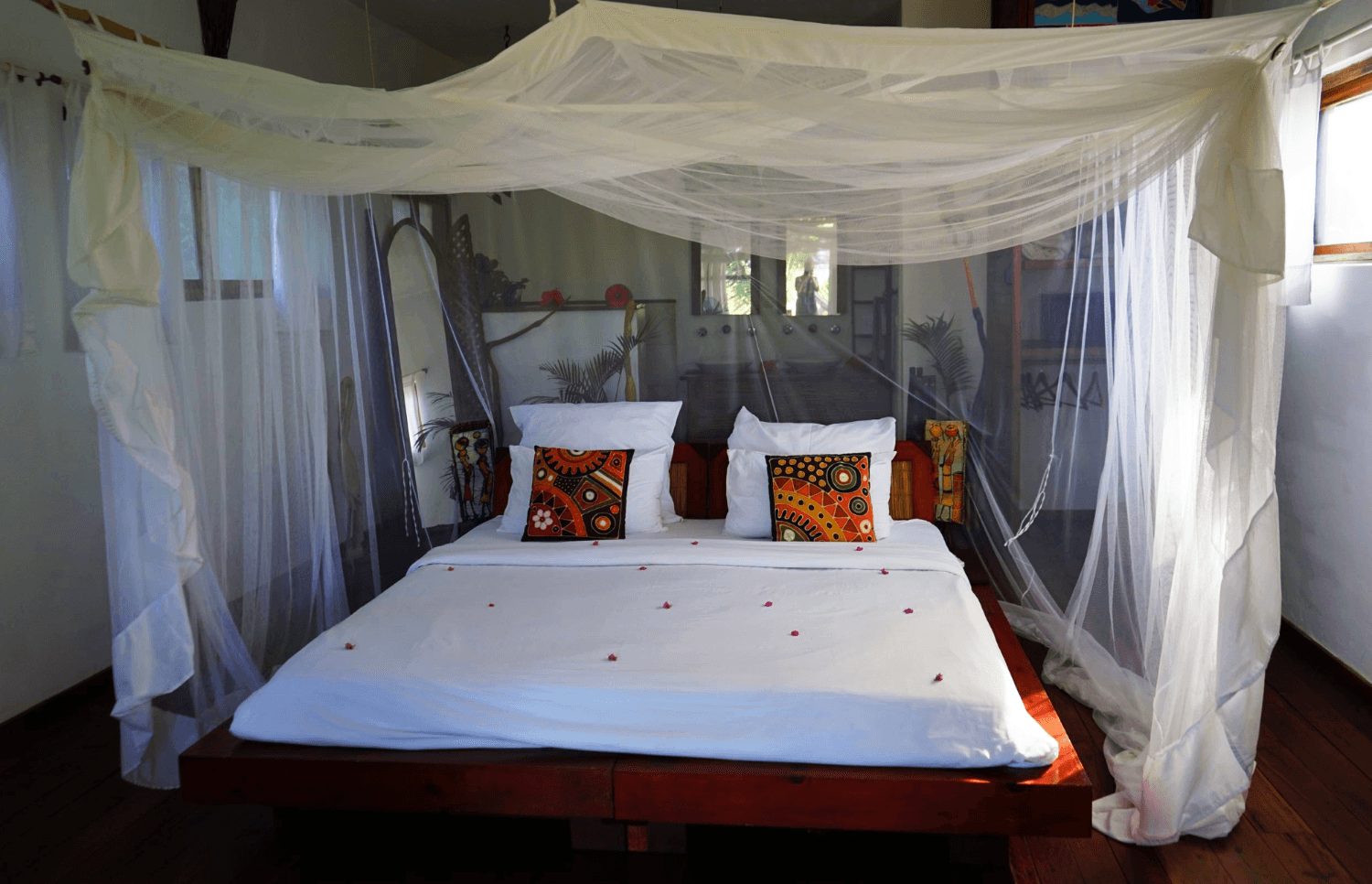
The Cost of Accommodation in Mozambique
Here’s where I stayed in the country:
GuestHouse 1109, Maputo: €47/night (single), €75/night (double)
This is easily one of the best-value guesthouses you’ll find in Maputo, which is otherwise pretty expensive for accommodation. My single room was basic but clean (the double rooms looked much bigger and nicer!), the pool was lovely, and the staff were super-friendly and helpful., with loads of useful tips about where to go and what to see in Maputo The hotel is in a great central location downtown, within walking distance of the cathedral and most of the city’s other attractions, and there’s a vey reasonably-priced airport transfer available if you need it. Breakfast is tasty if you decide to eat onsite, but I decided to try the nearby restaurants instead: there were several of them within a short walk.
Baia Sonambula, Tofo: €61/night (single), €86/night (double)
One of the best places I’ve ever stayed in and such great value for money! If you want a bit of luxury travel in Mozambique, stay at Baia Sonambula. The staff are incredible, it’s located just up from the beach, the rooms are gorgeous, the views are the best, the breakfasts are divine (and included!), and you even get free cake and coconut water every afternoon. I spent five nights and considered cancelling the rest of my trip in order to spend even longer there. I’m currently trying to convince all my friends to take a trip to Mozambique with me and it’s mostly so that I have an excuse to return to Baia Sonambula.
Baobab Backpackers, Vilanculos: €36/night
Baobab Backpackers is a standard backpackers hangout: it’s rustic, there are cockroaches, and the rooms are hot and humid. If, however, you’re looking for a chilled-out spot on the beach to make friends and be well-looked after, this is the place for you! Despite the relative discomforts (especially after my stay at Baia Sonambula), I really liked it and would stay here again. Lots of activities and excursions for you to take, there’s a restaurant on-site, which is useful if you’re feeling lazy, and the staff are so, so lovely.
Total cost for accommodation in Mozambique: €554 over 11 days = €50.36 per day.
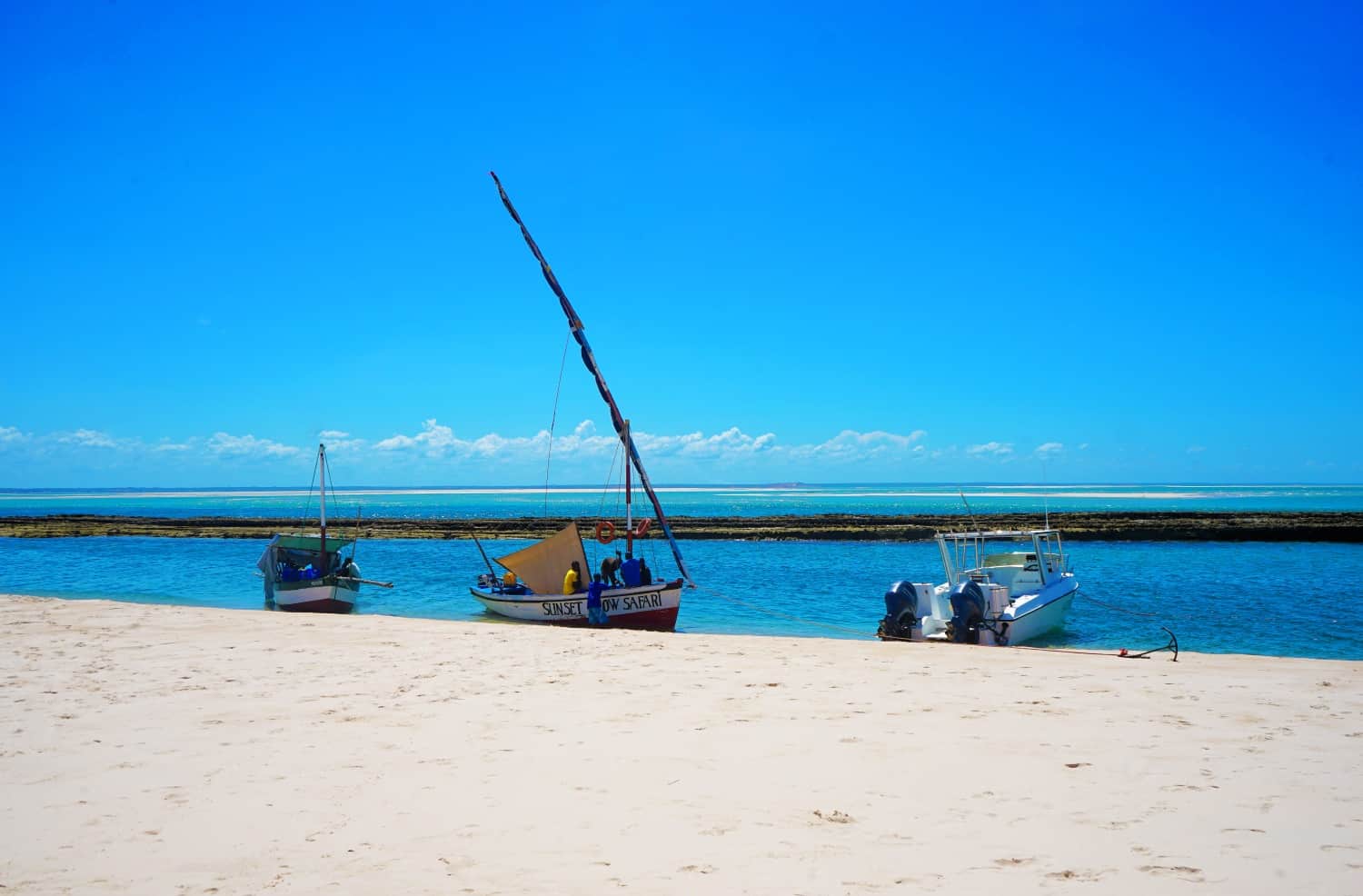
The Cost of Transportation in Mozambique
Transportation is unbelievably inexpensive if you’re willing to suck it up and ride the chapas. To quote from my post about what it’s like to travel in Mozambique: Imagine a humid minivan with poor suspension, swerving its way over pot-holed roads on a thirty-degree day. Now imagine filling it with 10 times more people than the recommended capacity until you’re all packed in the back like sweaty sardines. Maybe throw a child on your lap, a broken seat below your legs, and some pungent food in there, too. Now, get the driver to rip you off on the price.
Before arriving in the country, I planned to travel overland from place to place to save money, but it only took two days for me hand in my backpacker card and swear off using them. Unfortunately, though, if you’re not willing to use the chapas, don’t want to hitchhike, and don’t want to rent a car, there aren’t many other inexpensive overland transport options you can take.
So, yeah. I definitely splurged on transportation on this trip. I flew from Maputo to Inhambane for €92, then took a free hotel shuttle to Tofo (the entire journey would have been around €11 total by chapa), then to get from Tofo to Vilanculos, I splurged on hiring a private car after finding out the overland journey would involve a ferry, multiple chapas, and many hours stood alone on the side of the road attempting to flag a ride down. I didn’t feel comfortable hitchhiking as a solo woman.
Cities and towns in Mozambique are small, so you can walk basically everywhere you need to. I explored Maputo and Tofo on foot, and took tuk-tuks in Vilanculos in the evenings for safety reasons (the guesthouse staff told me it was unsafe to walk around at night). It cost around €1-2 each way to most places in the town.
Flight from Maputo to Tofo: €92
Private car transfer from Tofo to Vilanculos: €92
Three tuk-tuk rides: €5
My total cost for transportation in Mozambique: €189, or an average of €17.18/day
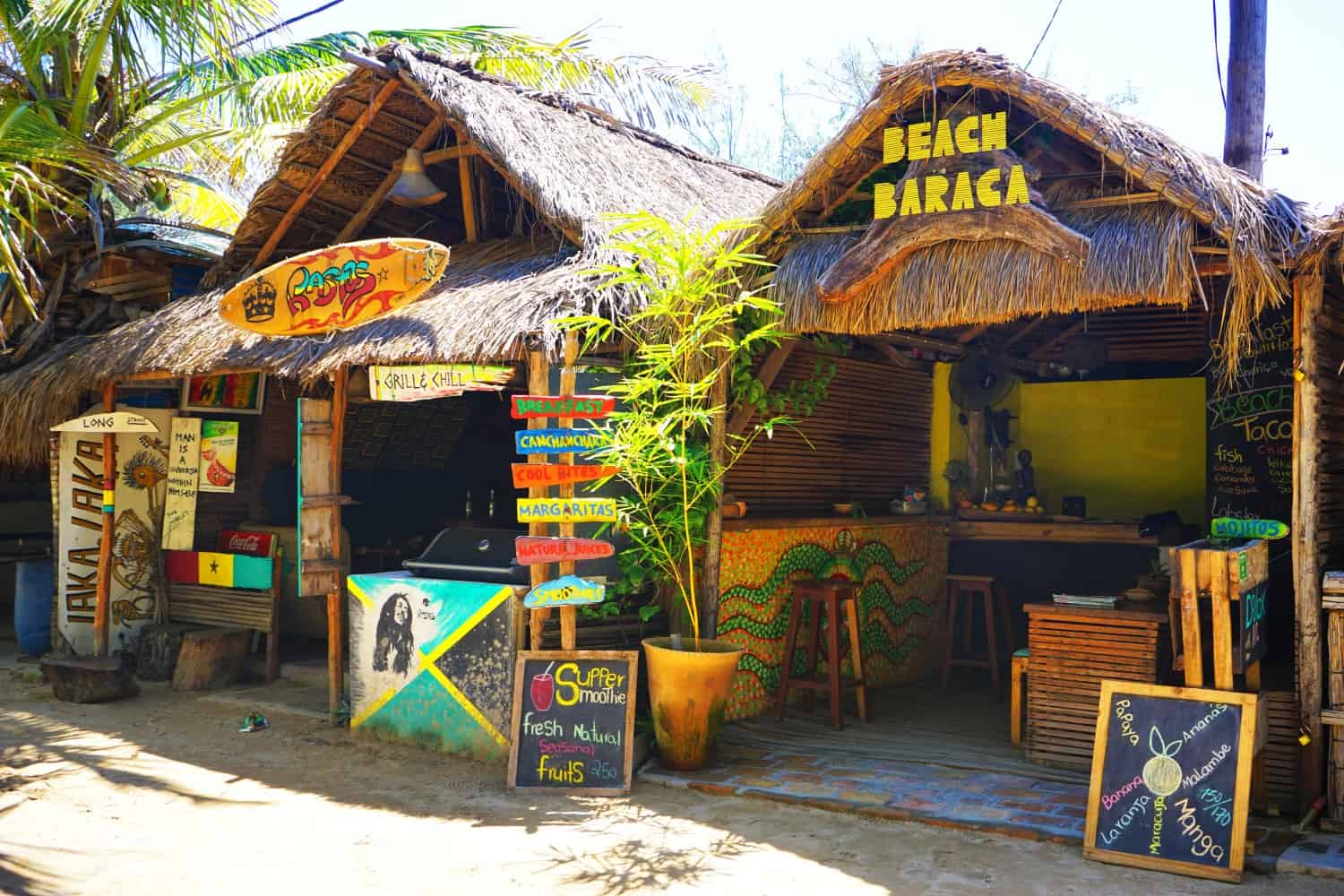
The Cost of Food in Mozambique
Food is cheap, cheap, cheap and delicious in Mozambique, and you definitely won’t go hungry. Portions were huge!
It was super-common for breakfasts to be included in the price of your room, and they were all pretty standard breakfast fare of toast, butter, scrambled eggs, some fruit, and coffee. Baobab Backpackers didn’t include breakfast but had a restaurant on site where you could grab an enormous omelette before hitting the sandbanks.
In Mozambique, you’ll find peri-peri-smothered everything and the enormous seafood platters will fill your stomach. Yes, if you’re not a fan of chilis or seafood, you may find yourself having to hang out in tourist restaurants every now and then.
The seafood is delicious, though, with some of the best prawns and crayfish I’ve ever had the pleasure of eating and some seriously great deals. A seafood platter split with two friends came to €6 each in Vilanculos, and was washed down with a €2 beer. I also had things like peri-peri chicken, bean curry, and smaller seafood meals like calamari or fish curries: they all set me back €5-7.
For something local that’s without Portuguese influence, there’s a dish called matapa, which is stewed cassava leaves, cooked with seafood and covered with peanuts, garlic, and coconut milk. I didn’t try it because I can’t eat peanuts, but friends who did liked it more than they expected. It typically costs €3-4.
Matapa is often served with xima, another super-common food you’ll find throughout Mozambique. Best described as a thick porridge or soft dough and made from maize flour, it’s unlikely to be something you order separately; rather, it’ll accompany many dishes in the same way that bread or rice might do elsewhere.
Speaking of bread, one of the many ways that Portuguese colonisation has influenced the local cuisine will be obvious the first time you pass a bakery. Crusty rolls known as pãozinho are very common in Mozambique; the same word is used in Portugal for a very similar type of roll, and you’ll likely get one served with your meal pretty often.
Drinking-wise, I used my Grayl water purifier bottle that kills 99.999% of all viruses, bacteria, and cysts in water, making it completely safe to drink. I drank the tap water everywhere in Mozambique, didn’t get sick, saved money on water bottles, and didn’t pollute the country with my plastic waste. I highly recommend grabbing one of these for your trip. If you’re short on space, a Steripen is a great option for making tap water drinkable.
When I wanted to drink something other than water, I usually went for either a soft drink or a beer. I typically paid about 50c for a bottle of Coke in a local restaurant, and around a euro for a large glass of Laurentina or 2M beer.
Fruit is insanely cheap in Mozambique, and especially if you eat multiple portions of it a day — you’ll find deals like 30 mangoes for 20c while you’re wandering around the markets, and the locals will be bemused if you want to buy just one.
I spent just €101 on food during my 11 days in the country. That’s €9.18 per day!
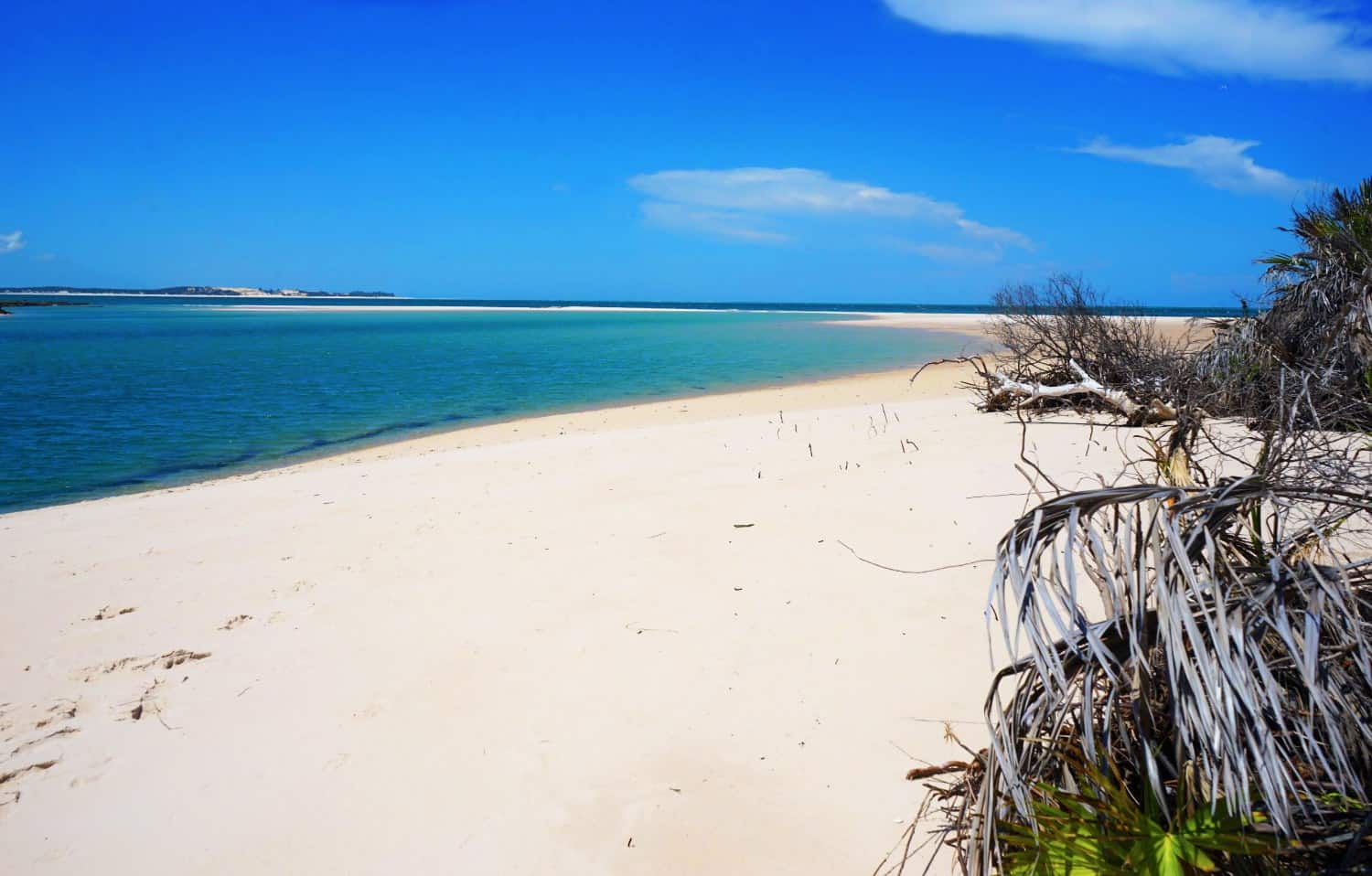
The Cost of Activities in Mozambique
To save money on activities in Mozambique, you should plan to wait until after you’ve arrived in the country to start booking experiences. Like many places around the world, the prices listed online for tours and activities are drastically higher than what you’ll pay by turning up and asking around.
It’s worth mentioning, too, that if you’re a solo traveller, you’ll find it beneficial to stay in hostels and take advantage of the group tours that are run for travellers. When looking at tours outside of my accommodation, group tours were rare, and private ones charged at least twice as much if you were alone.
So what type of activities can you expect to experience in Mozambique, and most importantly, how much do they cost?
The main star of the show here is hanging out with whale sharks. Tofo is one of the best places on the planet to swim with megafauna: whale sharks, manta rays, humpback whales, dolphins — and rarely, even hammerhead sharks. I took a boat trip with Liquid Dive Adventures, which cost €55 for a two-hour trip where I got to snorkel with whale sharks! It was amazing!! They also run scuba trips so you can get even closer to this amazing sea life: it costs €55 per dive.
In Vilanculos, I opted for an island excursion that was arranged through Baobab Backpackers. It cost €50 to spend a full day on Ilha de Magaruque and included snorkelling equipment and a fish barbecue lunch. This was my favourite experience in Mozambique and well worth the money I spent! I wish I’d had longer in Vilanculos so I could have jumped on another one of their tours.
In Mozambique, it is possible to rock up and negotiate with the local fishermen to hire a dhow for the day at a cheaper price, but you’re taking a risk by doing so. Hotel staff warned me of the dangers of doing this (potentially to convince me to take their tours, mind you!) and said there was a risk that the fishermen could take you out to an island, then ask for more money to bring you back.
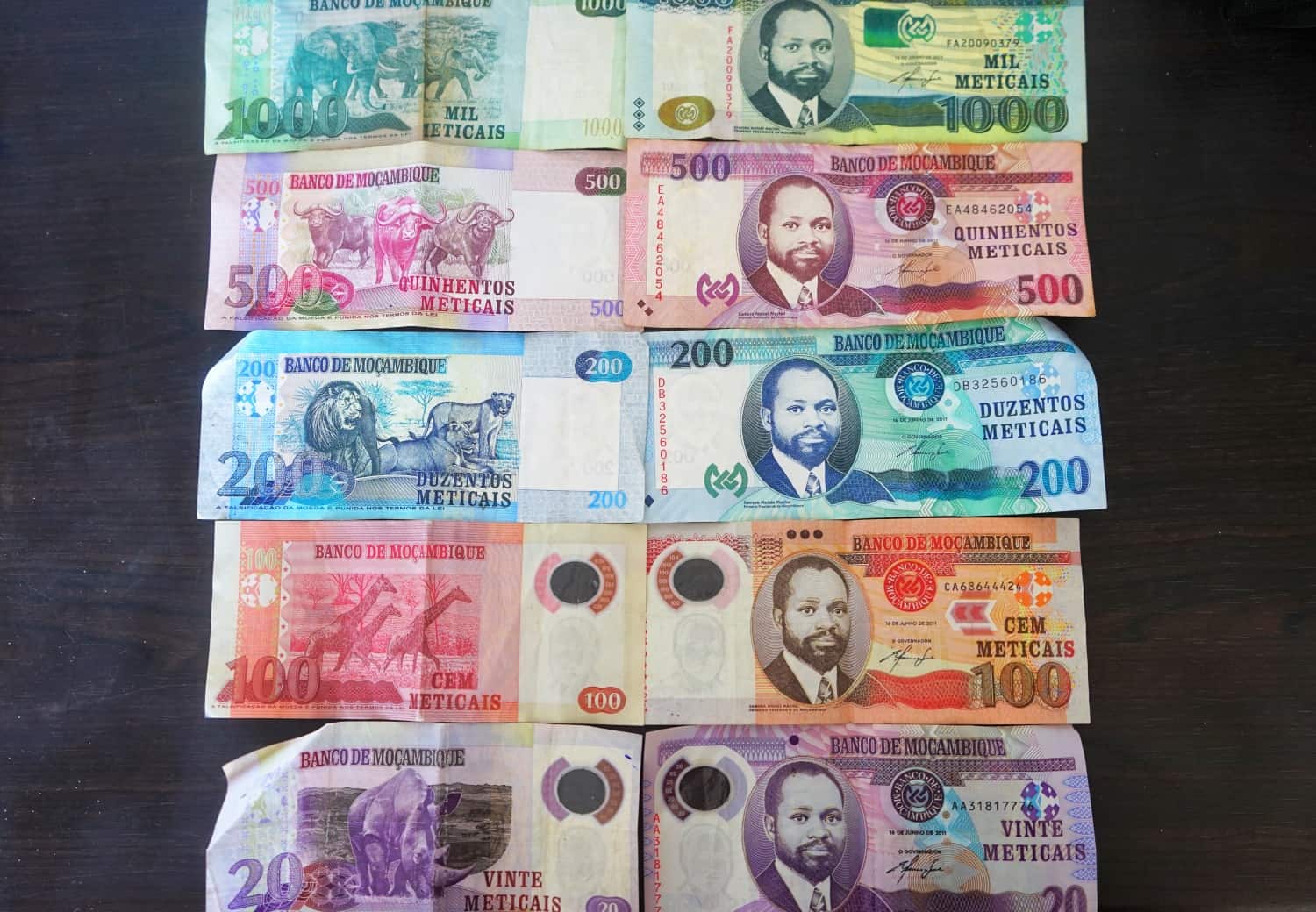
The Cost of Miscellaneous Stuff in Mozambique
Visas: Depending on where you’re coming from, a Mozambiquan tourist visa might be quite pricey, pretty cheap, or completely free! If you hold a passport from a SADC country, which includes South Africa and other nearby African countries, you’re exempt from tourist visa requirements for visits of up to three months.
Citizens of 29 other countries, including the UK and USA, can get a 30-day visa exemption on arrival for 650 MZN (€9.50). If none of that applies to you, you’re looking at $50 USD (€46.20) for a single entry tourist visa. Citizens of almost all countries can get a visa on arrival as long as you can prove you’re a tourist (print out of a copy of your flight out of the country and accommodation confirmations). You can also get an e-visa in advance, but it costs over twice as much for the same thing.
A local SIM card: Now. I don’t know about you, but one of my least favourite aspects of arriving in a new country is having to figure out how to get connected. Specifically: buying a local SIM card so that I have data to use while I’m in the country.
There’s locating a store that will sell you one, language barriers to deal with (in Mozambique, I did struggle with this), various forms of ID you might need to bring, scams to navigate, and… well, it’s a headache.
This year, I started using Airalo, which sells local e-SIM cards for travellers. What that means is that you can buy your SIM card online before you arrive in Mozambique, and then as soon as you land in the country, you can switch on your data and start using it. It’s worked flawlessly for me and I’ll never go back to physical SIM cards. You’ll pay between $8 (€7.40) for 1 GB of data and $24 (€22.20) for 5 GB of data and can top-up through the Airalo app.
Anti-malarial tablets: Mozambique was the first country where I took anti-malarials! The country has one of the highest risks of malaria in the world, and cerebral malaria is common, so you’ll really want to make sure you take anti-malarials and take them properly. I opted for generic Malarone tablets, which were €2.24 per tablet. Doxycycline is a much cheaper alternative at €0.18 per tablet, but requires you to also take the tablets daily for a month after you leave the country and is an antibiotic, which I definitely didn’t want in my system.
Travel insurance: If you’ve read any other posts on Never Ending Footsteps, you’ll know that I’m a great believer in travelling with travel insurance. I’ve seen far too many Go Fund Me campaigns from destitute backpackers that are unexpectedly stranded in a foreign country after a scooter accident/being attacked/breaking a leg with no way of getting home or paying for their healthcare. These costs can quickly land you with a six-figure bill to pay at the end of it.
In short, if you can’t afford travel insurance, you can’t afford to travel.
Travel insurance will cover you if your flight is cancelled and you need to book a new one, if your luggage gets lost and you need to replace your belongings, if you suddenly get struck down by appendicitis and have to be hospitalised, or discover a family member has died and you need to get home immediately. If you fall seriously ill, your insurance will cover the costs to fly you home to receive medical treatment.
I use SafetyWing as my travel insurance provider, and recommend them for trips to Mozambique. Firstly, they’re one of the few companies out there who will actually cover you if you contract COVID-19. On top of that, they provide worldwide coverage, don’t require you to have a return ticket, and even allow you to buy coverage after you’ve left home. If you’re on a long-term trip, you can pay monthly instead of up-front, and can cancel at any time. Finally, they’re more affordable than the competition, and have a clear, easy-to-understand pricing structure, which is always appreciated.
With SafetyWing, you’ll pay $1.50 (€1.40) a day for travel insurance.
Things to Know About Money in Mozambique
- You’ll pay for most things in Mozambican Meticals (pronounced meti-caish), but the South African rand and U.S. dollars are widely accepted, too.
- ATMs often run out of cash, and some of them just wouldn’t work with my Visa debit card, so if you can’t get money out of the first one you try, don’t panic! Try a few others before concluding that your card has been blocked.
- Expect to pay with cash in restaurants, but all accommodation I stayed at had card readers, and so did the tour companies.
- Tipping isn’t expected, but I like to tip a small amount anyway.
- You basically can’t change meticals outside of the country! I forgot about this and took a whopping €140 worth of meticals out of Mozambique with me, turned up in South Africa, and discovered nobody would change them. Fortunately-ish, Portuguese currency exchange places do change meticals, but at an appallingly bad rate. I got just €65 for mine once I landed back in Lisbon. If you aren’t headed to Portugal, though, don’t expect you’ll be able to change your money once you’ve left.
And that’s how much it costs to travel in Mozambique! I spent around €1010 for my 11 days in the country, which works out at €92 per day.
It’s not the cheapest country in the world, but it’s far from the most expensive, and there were definitely a number of ways I could have kept my costs down. If I’d been happy to stay in hostels, eat cheaply, travel overland, and minimise the number of activities I did, for instance, it wouldn’t have been hard to travel around for as little as €25-30 a day.
Have you been to Mozambique? How did my travel expenses stack up against yours?
Related Articles About Mozambique
🇲🇿 Mozambique Travel Guide: What’s it Like to Travel in Mozambique?
🏖 Introducing Tofo: My African Beach Paradise
🤿 A Perfect Day in the Bazaruto Archipelago
Save this to Pinterest:
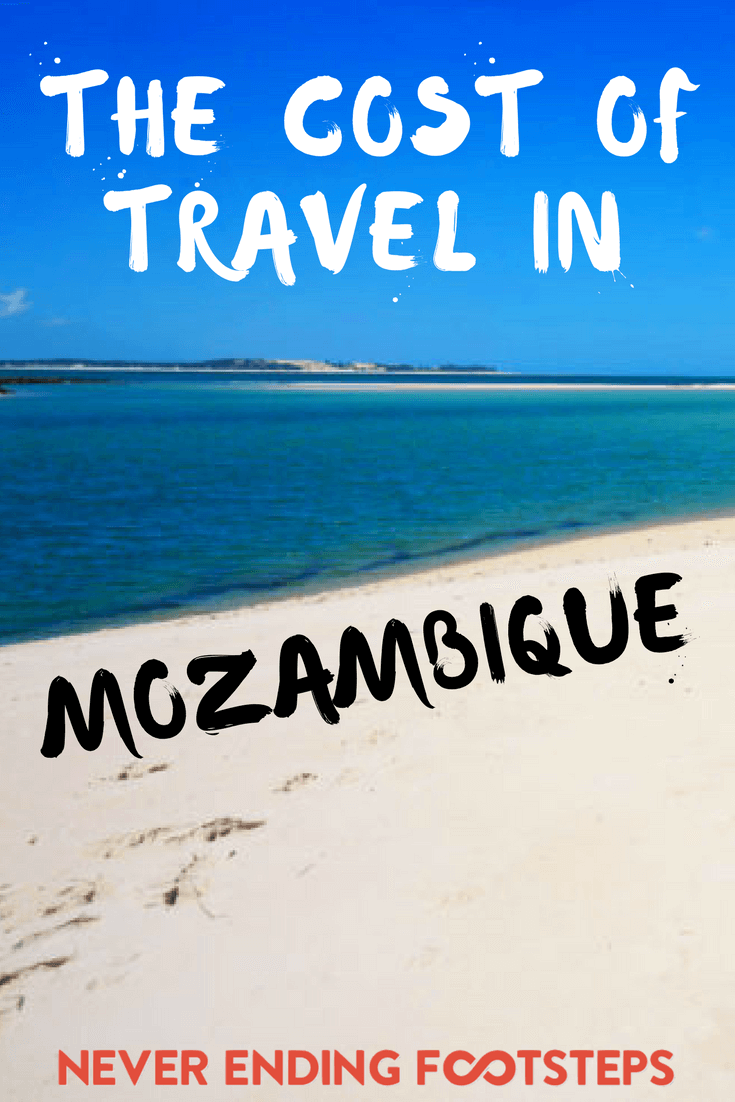







Great article! I do find 950 for 11 kinda pricy, but when you look how beautiful the scenery is, it feels like it is worth it.
x
Yep. I included more budget options for any readers who are stricter budget travellers than I am! I definitely splurged and treated myself on this trip :-)
Sounds like you had a fantastic time on a reasonable budget! The seafood platters sound incredible – can’t go wrong with prawns!
How was your trip to see the Whale Sharks?
Thanks for sharing this, looking forward to reading more about your trip :)
I’ll be writing an entire post about it, but man. I’ve never felt so sick before in my life. So it was sort of worth making the trip for me, but I also spent most of my time on the boat feeling like I was going to die, haha.
Did you snorkel or swim with the whale sharks? I thought you gave up snorkeling! And either way, it sounds amazing!
Snorkelled. And man, I’ve never felt so overwhelmingly sick before in my life, haha — I didn’t realise it would be in the full-on open ocean with some pretty wild waves. I swore off snorkelling, but the opportunity to swim with whale sharks was too tempting to turn down. And now that I’ve done that, I’m back to swearing off snorkelling again.
So glad you loved it! And very glad you have no incidents while there. Just do be aware that one must always be vigilant – which is probably why you got through with no crime incidents
Look forward to hearing about my home town of cape town
I was definitely more vigilant in Mozambique than anywhere else I’ve been in the world. It makes a big difference when you’re not flashing around an expensive camera or phone as you explore.
I loved Cape Town! I’m already plotting my return trip.
To visit Mozambique is out of my budget. But I really enjoyed your blog and found interesting and informative.
Thank you!
Are you not going to Tanzania? I’m going there in September and can’t find much useful info online! Do you have any tips? Great post! Love everything you write xx
Not on this trip, but hopefully later this year. Try Helen in Wonderlust for Tanzania: http://www.heleninwonderlust.co.uk/category/africa/tanzania/
Hey Lauren,
Thanks for the shout out!
Your trip looks amazing! I really want to get to Mozambique someday! Looking forward to reading some more!
Give me a shout if you go to Tanzania later in the year! I’m going to be there in October I think!
xxx
No problem! :-) I’ll definitely let you know if I happen to make it over there at the same time.
Amazing post Lauren..! Really enjoyed it. Pictures are stunning.. Food habits and the prices sounds great… Seems like nothing to worry about food while your stay in there. Thanks for sharing.
Definitely not! The food is amazing and I don’t think I’ve ever got sick from eating there.
Such a lovely post. I am planning on doing a similar trip so i found the budget elements very helpful. I laughed at your description of the public transport-it is like an adventure in itself.
Oh, I’m glad you found it useful, Tsitsi! Hope you have a wonderful time in Mozambique, even while on the public transport :-)
Great post…! Funnily enough, this place looks a little similar to Sri Lanka. Have you been?
I have! I didn’t find them too similar in terms of scenery, but the lack of backpackers on the beach is definitely something they have in common!
Thanks so much for this post, I’ll be in Mozambique in 2 weeks! I’d already booked Baia Sonambula so I’m thrilled to hear it’s as wonderful as it looks on the site! I’m only just starting to research bits and pieces now (I tend to just decide what to do when I get somewhere) but all of your tips are well noted! :-)
Ah, amazing! I promise you’ve LOVE Baia Sonambula. It’s fantastic!
Dear Lauren,
Thank you for this interesting post.
We get a lot of informations from this.
We plan to visit Mozambique on August.
We have some transport concern…indeed we couldnt find a private transport from Vilanculos to Gorogonsa National Park. We find someone who could do this trip for 350$…which is very expensive. Do you have a company to recommand ?
Thank you for your help
Karim
I don’t know of any. But it might be worth contacting the accommodation you’re planning to stay with in Vilanculos, and they may be able to hook you up with a driver.
Ahh thanks for this breakdown it is so helpful as I am planning a trip in Nov 2018 for my birthday and want to spend it in Vilanculous…….